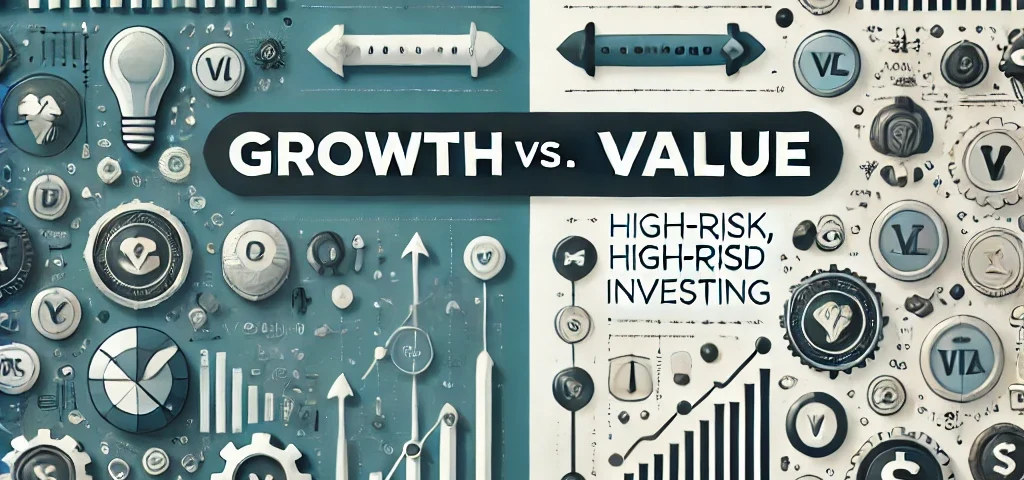
Dividend Investing Strategies: An Investor’s Guide
05/10/2024
How to Invest in Real Estate A Step-by-Step Guide
09/10/2024Growth Vs. Value Investing: A Comprehensive Guide

Growth Vs. Value Investing: A Comprehensive Guide
Growth Vs. Value Investing: A Comprehensive Guide
Introduction
Navigating through the stock markets can seem like wading across a sea of investment possibilities, which could occasionally be overwhelming. Two of the potentially prosperous strategies for risk management and substantial returns are growth and value investing. In the bewildering world of investment trends, understanding the differences between these two methodological avenues can help you tailor the most suitable strategy according to your long-term financial goals.
In this comprehensive guide, we explore growth vs. value investing, their concepts, advantages, drawbacks, as well their critical distinctions.
Growth Investing: Concept, Advantages, & Drawbacks
Understanding Growth Investing
Growth investing is a strategy that exclusively focuses on investing in high-growth companies predicted to generate returns above average compared to other stocks in the market. Growth investors are keen on companies that reinvest their earnings into further development, expansion, or innovation, thus signaling potential for increased future revenues.
Advantages of Growth Investing
- Potential High Returns: The primary advantage of growth investing is its potential for substantial returns. Companies in a rapid growth phase often witness hefty profit increases, which could lead to their stocks experiencing sharp appreciation.
- Capital Appreciation: Growth stocks generally prioritize capital appreciation over dividend payouts, fitting the needs of investors seeking substantial returns over a long-term horizon.
- Inflation Protection: Since growth stocks often lead the market, they can safeguard your portfolio against inflation.
Drawbacks of Growth Investing
- Increased Risk: Emphasizing highly growing companies means these stocks are often more volatile and riskier than their counterparts. Losses, when they occur, can be equally significant.
- Overvaluation: There is a risk of overvaluing companies with a lot of growth potential but little current profitability.
- No Dividends: Growth stocks rarely pay dividends, which significantly reduces their attractiveness for investors seeking income generating investments.
Value Investing: Concept, Advantages, & Drawbacks
Understanding Value Investing
Value investing, originated by Benjamin Graham and further popularized by Warren Buffet, primarily involves purchasing undervalued stocks and holding them over the long-term. Value investors look for stocks trading for less than their intrinsic or book value, thus offering a margin of safety.
Advantages of Value Investing
- Low Risk: Because value stocks usually have a discounted price, they often carry less risk compared to growth stocks.
- Dividend Income: Many value stocks belong to mature companies that distribute dividends, making them an attractive investment choice for income-seeking investors.
- A Contrarian Approach: Since value investors buy stocks that are currently out of favor in the market, they can potentially achieve higher returns once the market corrects itself.
Drawbacks of Value Investing
- Requires Patience: Value investing requires a long-term horizon and hence, demands a significant amount of patience from investors.
- Possibility of Value Traps: Some stocks may appear undervalued, however, they may be cheap for a reason due to poor business performance or low market confidence.
- Slow Growth: Typically, value stocks are not high-growth companies and hence, may take longer to yield significant returns.
Growth Vs. Value Investing: Key Distinctions
Although both growth and value investing strategies aim to maximize returns, they differ fundamentally in their approach. Here are some key distinctions:
- Risk and Return Ratio: Growth investing has a higher risk-return ratio. They boast potential for significant profits but also greater risks. Conversely, value investing offers lower risk and consistent returns over a longer period.
- Stock Selection: Growth investors prioritize companies with high potential for future earnings growth. In contrast, value investors seek out undervalued companies trading below their intrinsic value.
- Investment Horizon: Growth investing often suits those looking for high returns in a shorter period, while value investing aligns with a longer-term approach.
Conclusion
In the Growth vs. Value Investing debate, each strategy brings unique attributes to the table. Both methodologies can prove valuable and offer considerable returns when appropriately applied. As an investor, the elementary factor determining your choice should be your individual risk tolerance, financial goals, and investment horizon. In the end, having a well-rounded, diversified portfolio that boats both value and growth stocks might be the most effective way to steer through the ever-volatile investing landscape.


